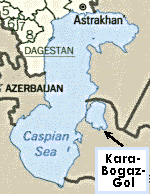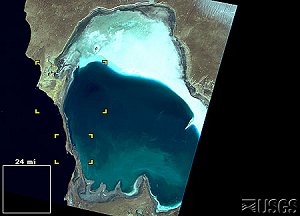
Caspian Sea
The Caspian Sea is a very large, inland body of water that is about 740 miles long and 140-300 miles wide, with an area of about 150,000 square miles. It's surrounded by the nations of Russia, Kazakhstan, Turkmenistan, Iran, and Azerbaijan. It's 28 meters below sea level, and it is somewhat salty (1.5%) because water leaves only by evaporation. The Caspian's most important source of water is the Volga River.

The Volga River is about 2300 miles long. It begins north of Moscow, and is joined by the Kama River south of Kazan. Its delta is enormous, beginning over 100 miles from the Caspian Sea:
The Volga is basically synonymous with Russia, and therefore I would like to use it to characterize the birth of Russia because the Caspian Sea is shaped like (after we turn it upside down)...

...a baby!
And it's upside down, as if still in the womb. I believe our Father made it so that we would consider the origins of Russia, especially in the Bible. I think one important clue is its connection with the Black Sea via the Caucasus Mountains (see previous map); another, that it is right beside the heel of Russia. The Volga River delta then represents the placenta of this developing baby, and the river itself is the umbilical cord; the baby receiving its life-blood from mother Russia, as it were. Why isn't it near the belly button? We'll consider that shortly.
Many people believe that the father of Russia is Esau. Let's take a look at his birth in Genesis 25:
20 And Isaac was forty years
old when he took Rebekah to wife, the daughter of Bethuel the Syrian of
Padanaram, the sister to Laban the Syrian. 21 And Isaac entreated the LORD for
his wife, because she was barren: and the LORD was entreated of him, and Rebekah
his wife conceived. 22 And the children struggled together within her; and she
said, "If it be so, why am I thus?" And she went to inquire of the LORD.
23 And the LORD said unto her, "Two nations are in thy womb, and two
manner of people shall be separated from thy bowels; and the one people shall be
stronger than the other people; and the elder shall serve the younger." 24 And
when her days to be delivered were fulfilled, behold, there were twins in her
womb. 25 And the first came out red, all over like an hairy garment; and they
called his name Esau. 26 And
after that came his brother out, and his hand took hold on Esau's heel; and his name was called
Jacob: and Isaac was threescore years old when she bare them.
Here is what our Father thinks of Esau, in Malachi 1:
1 The burden of the word of the
LORD to Israel by Malachi. 2 "I have loved you," saith the LORD. Yet ye say,
'Wherein hast thou loved us?' Was not Esau Jacob's brother? saith the LORD:
yet I loved Jacob, 3 And I hated Esau, and laid his mountains and his
heritage waste for the dragons of the wilderness.
Esau's land was
called Edom, meaning 'red'.
4 Whereas Edom saith,
'We are impoverished, but we will return and build the desolate places;' thus
saith the LORD of hosts, They shall build, but I will throw down; and they shall
call them, The border of wickedness, and, The people against whom the LORD hath
indignation for ever.
Paul quotes from both of these chapters in Romans 9:
9 For this is the word of promise, "At this time will I come, and Sarah shall have a son." 10 And not only this; but when Rebecca also had conceived by one, even by our father Isaac; 11 (For the children being not yet born, neither having done any good or evil, that the purpose of God according to election might stand, not of works, but of Him That calleth;) 12 It was said unto her, "The elder shall serve the younger." 13 As it is written, "Jacob have I loved, but Esau have I hated."
Our next step is to consider that Russia was formerly known as the land of Rus. Because of this, many people believe there is a prophecy directed at Russia in Ezekiel 38:
1 And the word of the LORD came
unto me, saying, 2 "Son of man, set thy face against Gog, the land of Magog, the
chief prince of Meshech and Tubal, and prophesy against him,
This
is the note from the side column of The Companion Bible: "the chief prince = the
head, or leader of Rosh. Heb. Ro'sh, which may point to Russia."
3 And say, 'Thus saith the Lord GOD; Behold, I am
against thee, O Gog, the chief prince of Meshech and Tubal: 4 And I will turn
thee back, and put hooks into thy jaws, and I will bring thee forth, and all
thine army, horses and horsemen, all of them clothed with all sorts of armour,
even a great company with bucklers and shields, all of them handling swords:
The Septuagint (Greek Old Testament) uses the proper name Ros instead of translating it like the King James did. It also occurs in chapter 39:
1 Therefore, thou son of man,
prophesy against Gog, and say, 'Thus saith the Lord GOD; Behold, I am against
thee, O Gog, the chief prince of Meshech and Tubal: ...
6 And I will
send a fire on Magog, and among them that dwell carelessly in the isles: and
they shall know that I am the LORD. 7 So will I make My holy name known in the
midst of My people Israel; and I will not let them pollute My holy name any
more: and the heathen shall know that I am the LORD, the Holy One in
Israel.
I believe that Gog and Magog are terms used to represent all heathens, as well as Russia, especially in the east, at the time just prior to the second advent. The same terms are used of heathens who attack the holy city just prior to judgement day (Revelation 20:8), making the former event a type of what will be quite final in the latter.
Here is a quote about the name Rosh from the Gesenius Hebrew-Chaldee Lexicon to the Old Testament [with my additions in square brackets]: "proper name of a northern nation, mentioned with Tubal and Meshech; undoubtedly the Russians, who are mentioned by Byzantine writers of the tenth century, under the name oi Ros, dwelling to the north of Taurus [Mountains in Turkey], and described by Ibn Fosslan, an Arabic writer of the same age, as dwelling on the river Rha (Wolga [Volga])."
The Russians built dams along the Volga which dramatically reduced the amount of water flowing into the Caspian Sea. This, combined with irrigation projects, lowered the water level by 3 meters, and by 1977 it had lost 10 percent of its surface area, or 15,000 square miles. It has recovered 2 meters, but what was affected the most is another body of water that's not so obvious on previous maps. It's a lake called Kara-Bogaz-Gol (KBG), which means 'black throat lake', and it's right beside the 'throat' of the Caspian child. Here it is on an older map:

This lake isn't as noticeable in the other maps because it was shrinking drastically. Here are 2 satellite images of the lake from USGS Earthshots. The image on the left was taken in 1972, the other in 1987.


KBG is about 7000 square miles in size, but only a few meters deep, so
excessive evaporation results in a substantial loss of area. It's saltier than
the Caspian Sea. At one point the salt concentration was about 35 percent. It's
about 2-3 meters lower than the Caspian Sea, and water rushes in through a
narrow strait connecting the two:

The Soviets dammed this strait in 1980, and the lake dried up completely 3 years later. The dam is gone now, and the lake appears to have recovered. The following satellite image was taken in October of 1999:
Since the throat is our most vulnerable spot, I believe we are to learn from this lake about Esau's tenuous existence. He is on his way to hell unless he does a drastic turnabout. If your spiritual water supply dries up - and Christ is the Living Water (John 7:37-39) - your spirit dies.
Now let's move down a ways, and focus on the child's belly button where we'll find two faces; first the face of a man(in the water):

And when we turn him upside down we find...

...the face of a woman!
Note that for both, the nose of one is the mouth of the other. I believe this is to emphasize the breath of life; that is, to represent the life that parents give to their children, as in Genesis 2:
7 And the LORD God formed man of the dust of the ground, and breathed into his nostrils the breath of life; and man became a living soul.
So at the child's belly button are his parents, and at their belly buttons are their parents, and so on. However, Esau spoiled his genealogy by marrying two Hittites, and later a daughter of Ishmael (Genesis 36:2-3). He also despised his birthright (Genesis 25:34).
It appears that many Russians have gone the way of the unbelieving heathens of the east, and they will attack the house of Israel in the future, as He stated in Ezekiel 38:
16 And thou shalt come up
against My people of Israel, as a cloud to cover the land; it shall be in the
latter days, and I will bring thee against My land, that the heathen may know
Me, when I shall be sanctified in thee, O Gog, before their eyes. ...
23
Thus will I magnify Myself, and sanctify Myself; and I will be known in the eyes
of many nations, and they shall know that I am the LORD.
|
© 2006 God's Geography
|